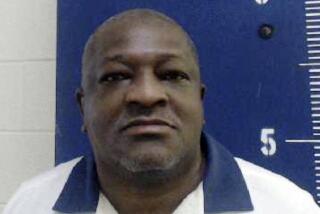Oklahoma halts double execution after one is botched
A controversial double execution in Oklahoma was scrubbed Tuesday night after the first inmate to receive an experimental three-drug cocktail writhed and grimaced on the gurney, struggled to lift his head and died of a heart attack more than 40 minutes later, officials and witnesses said.
Clayton Lockett’s bizarre death came after a constitutional showdown in Oklahoma over state execution secrecy laws. It is likely to provoke strong criticism from death penalty critics at a time when similar policies for lethal injections have come under fire across the nation.
The botched execution will have a huge effect, Deborah W. Denno, a professor at Fordham Law School and a death penalty expert, told the Los Angeles Times. “The entire world was watching this execution.”
According to reporters at the scene, Lockett, 38, received the first dose of the three-drug cocktail at 6:23 p.m.
The drugs were midazolam, which causes unconsciousness; vecuronium bromide, which stops respiration; and potassium chloride, which stops the heart. They are administered in that order. The state has said the procedure is meant to involve three doctors with hand-held syringes, injecting the drugs into IV lines in both the inmate’s arms.
At 6:33 p.m., 10 minutes after the execution began, a doctor said Lockett was unconscious. But three minutes later, Lockett began to nod and mumble and writhe, witnesses said.
The following account of Lockett’s death was tweeted after the fact by AP and Tulsa World reporters covering the execution.
He was conscious and blinking, licking his lips even after the process began. He then began to seize.— Bailey Elise McBride (@baileyelise) April 30, 2014
Prison officials said they will try to get Lockett to hospital to resuscitate him.— Bailey Elise McBride (@baileyelise) April 30, 2014
Clayton Lockett died inside the execution chamber at 7:06 pm of a massive heart attack according to DOC officials.— Cary Aspinwall (@caryaspinwall) April 30, 2014
A spokesman for the Oklahoma Department of Corrections, citing comments by the department’s director, Robert Patton, confirmed to the Los Angeles Times that Lockett did not die immediately after the lethal injection was administered.
“The director did say that it appears that a vein [in Lockett’s body] blew up or exploded, it collapsed, and the drugs were not getting into the system like they were supposed to,” spokesman Jerry Massie said.
Massie said that after the new injection was administered, the condemned man “was obviously showing some movement.”
“After several minutes, five minutes, he was not unconscious,” Massie said. “They made a decision to halt the execution, but at 7:06 he suffered a massive heart attack and expired.”
Massie said the inmate had a physician attending to him, a doctor who does not work for the department. Massie could not say whether that physician had ordered the inmate to be taken to a hospital.
Oklahoma Gov. Mary Fallin had strongly pushed for Tuesday night’s double execution. She issued a statement acknowledging the botched death and ordered a two-week delay in the execution of Charles F. Warner, who was to die after Lockett on Tuesday night.
“I have asked the Department of Corrections to conduct a full review of Oklahoma’s execution procedures to determine what happened and why during this evening’s execution of Clayton Derrell Lockett,” Fallin said.
Massie would not say whether the department could extend Warner’s two-week stay based on the department’s review of what happened with Lockett.
“We’ll just see what develops,” he said.
Lockett was convicted of a woman’s murder in 1999. Warner, who was convicted of killing his girlfriend’s baby daughter in 1997, has maintained his innocence.
One of Lockett’s attorneys, Dean Sanderford, witnessed the execution from the same room as the reporters. Lockett’s movements started as twitching and ended like a seizure, he said. “What we saw was somebody coming back to consciousness.”
Then the blinds went down and the microphone in the death chamber was turned off.
“Exactly what we were worried about happened,” Sanderford said. “He died in pain.”
Warner’s attorney, Madeline Cohen, called Lockett’s death “horrible and certainly something we hope and pray will never happen.”
“Our feeling right now is that until there is a full investigation including an independent autopsy and full transparency about the drugs, Oklahoma should not be executing anybody else,” said Cohen, who was not in the observation room. “We will take all possible legal steps to get some light on this process.”
News of the botched execution prompted a storm of criticism Tuesday evening.
Many blamed recalcitrant public officials in Oklahoma for forcefully pursuing an experimental and secretive lethal injection method, and some blamed the U.S. Supreme Court for refusing to weigh in on similar execution secrecy cases in other states across the U.S.
“This is one of the worst botches that we’ve had,” said Fordham Law School’s Denno. “All of this was predictable and foreseeable. How many times does this have to take place? ... We have all the evidence we need to show this is a highly problematic and potentially unconstitutional procedure.”
The American Civil Liberties of Oklahoma likened the state’s execution process to “hastily thrown together human science experiments” and called for an immediate moratorium.
Attorneys for Lockett and Warner had warned such mishandling could come to pass. They had sued in state court, demanding to know the source of the drugs, but lost.
Cohen issued a thundering condemnation of the state Tuesday morning.
“Tonight, in a climate of secrecy and political posturing, Oklahoma intends to kill two death row prisoners using an experimental new drug protocol, including a paralytic, making it impossible to know whether the executions will comport with the Eighth Amendment’s ban on cruel and unusual suffering,” Cohen said in the statement.
“Despite repeated requests by counsel, the state has refused, again, and again, to provide information about the source, purity, testing and efficacy of the drugs to be used. It’s not even known whether the drugs were purchased legally,” Cohen said.
The state attorney general’s office had responded by saying those claims were false and that officials were providing information on execution protocols and the names and contents of the drugs being used.
After the botched execution, a spokesman for Oklahoma Atty. Gen. Scott Pruitt issued a brief statement: “We are gathering information on what happened tonight in order to evaluate.”
A legal back-and-forth between defense attorneys and prosecutors is not unusual right before executions.
But what sets Oklahoma’s case apart is the high-profile constitutional showdown that preceded it. The state’s Supreme Court briefly halted the executions, then reversed itself after intense criticism from the state’s conservative lawmakers.
Gov. Fallin accused the Supreme Court of overstepping its bounds in issuing the stay. She threatened to go ahead with the executions anyway. State legislators threatened to impeach the justices.
The court withdrew its opposition and the executions were authorized to proceed. (You can read more about that back-and-forth in this piece by legal analyst Andrew Cohen.)
The state that performs the most executions, Texas, said Oklahoma’s incident would not prompt any changes there. “Texas does not use the same drugs,” a Department of Corrections spokesman said. “We use a single lethal dose of pentobarbital and we have done so since 2012.”
Tuesday’s botched execution could eventually force the U.S. Supreme Court to reconsider whether the death penalty constitutes cruel and unusual punishment, which is barred by the Constitution.
Six years ago, the high court rejected a “cruel and unusual punishment” challenge to lethal injections in a Kentucky case. In that case, prisoners’ attorneys argued that prison officials could not be trusted to administer the three drugs in a way that would ensure a condemned prisoner was put to death without suffering great pain.
A divided U.S. Supreme Court ruled the states could proceed with lethal injections so long as they developed good and safe procedures for administering the drugs. But the court left the door for future challenges.
The Oklahoma case is sure to be cited as strong evidence that state prison authorities cannot be trusted to capably administer lethal injections.
Erwin Chemerinsky, dean of UC Irvine Law School, said as much in a statement Tuesday night: “For the state to inflict such great suffering is the very definition of cruel and unusual punishment. Courts must step in and prevent executions with such untested protocols that have the potential for inflicting such terrible suffering.”
Jen Moreno, an attorney with the Death Penalty Clinic at UC Berkeley, called on Oklahoma officials to disclose how much of each drug in the cocktail were administered and whether the process went correctly. She said she would want to know, for example, whether the vein popped because of a misplaced IV or if the drugs did not go down the tube properly.
“Part of the issue we see in Oklahoma, Missouri and Louisiana is they aren’t willing to provide a lot of details,” Moreno said, referring to other states with lethal-injection secrecy policies that prevent defendants’ attorneys from getting extensive details about where the states’ drugs are coming from. “The states are taking actions that have bad consequences, but they also have all the information. Until plaintiffs have access to those answers, we’ll continue to see this happen.”
John Blume, a Cornell law professor and death penalty expert, told The Times, “Hopefully, this will end any argument that there does not need to be complete transparency regarding the execution process, including the nature of the drugs and who provides them.”
David Savage in Washington contributed to this report.
More to Read
Start your day right
Sign up for Essential California for news, features and recommendations from the L.A. Times and beyond in your inbox six days a week.
You may occasionally receive promotional content from the Los Angeles Times.









